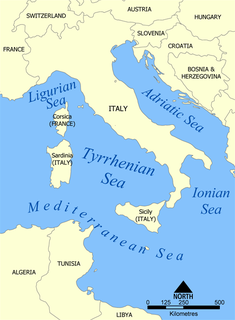
The Tyrrhenian Sea is part of the Mediterranean Sea off the western coast of Italy. It is named for the Tyrrhenian people, identified since the 6th century BCE with the Etruscans of Italy.

Milazzo is a town (comune) in the Metropolitan City of Messina, Sicily, southern Italy; it is the largest commune in the Metropolitan City after Messina and Barcellona Pozzo di Gotto. The town has a population of around 31,500 inhabitants.

Taormina is a comune (municipality) in the Metropolitan City of Messina, on the east coast of the island of Sicily, Italy. Taormina has been a tourist destination since the 19th century. Its beaches on the Ionian sea, including that of Isola Bella, are accessible via an aerial tramway built in 1992, and via highways from Messina in the north and Catania in the south. On May 26–27, 2017 Taormina hosted the 43rd G7 summit.
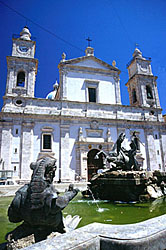
Caltanissetta is a comune in the central interior of Sicily, Italy, and the capital of the Province of Caltanissetta. Its inhabitants are called Nisseni.
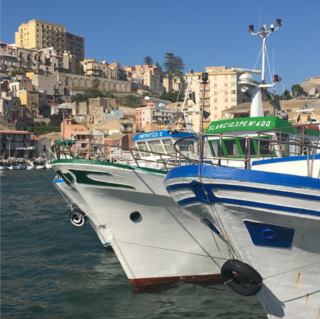
Sciacca, is a town and comune in the province of Agrigento on the southwestern coast of Sicily, southern Italy. It has views of the Mediterranean Sea.
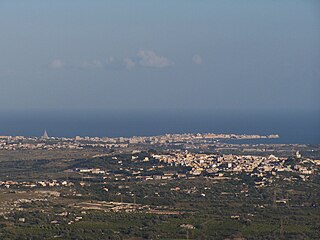
The Province of Syracuse is a province in the autonomous island region of Sicily in Italy. Following the suppression of the Sicilian provinces, it was replaced in 2015 by the Free municipal consortium of Syracuse. Its capital is the city of Syracuse, a town which was established by Greek colonists arriving from Corinth in the 8th century BC. It has an area of 2,109 square kilometres (814 sq mi) and a total population of 403,985 (2016). Syracuse has 8% of the Sicilian population and 8.2% of Sicily's area.

Isola Bella is a small island near Taormina, Sicily, southern Italy. Also known as The Pearl of the Ionian Sea, it is located within a small bay on the Ionian Sea; it was a private property owned by Florence Trevelyan until 1990, when it was bought by the Region of Sicily, being turned into a nature reserve, administrated by the Italian branch of the World Wide Fund for Nature. There is a narrow path that often connects the island to the mainland beach. The island is surrounded by sea grottos and has a small and rather rocky beach which is a popular destination for sunbathers.

Naxos or Naxus was an ancient Greek city of Sicily on the east coast of the island between Catana and Messana. It was situated on a low point of land at the mouth of the river Acesines, and at the foot of the hill on which was afterwards built the city of Tauromenium.

The Castello Maniace is a citadel and castle in Syracuse, Sicily, southern Italy. It is situated at the far point of the Ortygia island promontory, where it was constructed between 1232 and 1240 by the Emperor Frederick II. It bears the name of George Maniakes, the Byzantine general who besieged and took the city in 1038. Originally, one could only enter the castle over a bridge spanning a moat. A feature of the castle is the decorated portal. Today the castle is open to public and is a local tourist attraction in Syracuse.
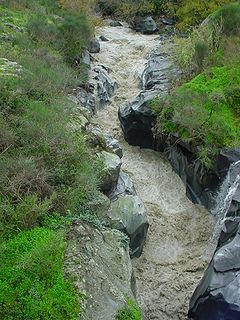
The Alcantara is a river in Sicily, southern Italy. It has its source on the south side of Monti Nebrodi and its mouth in the Ionian Sea at Capo Schiso in Giardini-Naxos. The river is 52 kilometres (32 mi) long.

Sambuca di Sicilia is a comune (municipality) in the Province of Agrigento in the Italian region Sicily, located about 68 kilometres (42 mi) southwest of Palermo and about 89 kilometres (55 mi) northwest of Agrigento.

Calatabiano is a comune (municipality) in the Metropolitan City of Catania in Sicily, southern Italy.

The Castello normanno is a castle in Paternò, in the Province of Catania, Sicily, southern Italy.

Vignazza Tower is a 16th-century coastal watchtower in Giardini Naxos, Sicily. Today, the tower is in good condition.

Lentini, historically Leontini or Leontinoi, is a town and comune in the Province of Syracuse, South East of Sicily.

The Garden of Ninfa is a landscape garden in the territory of Cisterna di Latina, in the province of Latina, central Italy. The park has an area of 105 hectares, and is an Italian natural monument. The landscape garden within the park comprises 8 hectares and contains medieval ruins, several oaks, cypresses and poplars, grassy meadows, a wide range of exotic plants from various parts of the world, numerous watercourses and a large variety of rambling roses growing over the stone walls of the ruins. The site is run by the Italian foundation Fondazione Roffredo Caetani. It is open to the public at set times from April to November. Nearby towns include Norma and Sermoneta. Ninfa has been described as "the most romantic garden in the world".

The Borgo Storico Seghetti Panichi near Ascoli Piceno in Marche region of central Italy comprises a 13th to 18th-century villa, a 19th-century romantic landscape by Ludwig Winter, a 16th-century chapel to St. Pancras and a farmstead which has been converted into a hotel.
The Castello di Villagonia was a castle near the seashore of Taormina, Sicily. It was built in the Middle Ages by the De Spucches noble family. In the early 16th century, the castle was integrated into the Capo Schisò defensive system to defend the area from raids by the Barbary pirates.

























